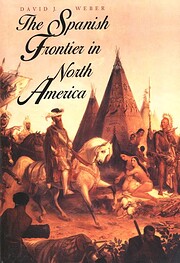

Click on a thumbnail to go to Google Books.
|
Loading... The Spanish frontier in North America (original 1992; edition 1992)by David J. Weber
Work InformationThe Spanish Frontier in North America by David J. Weber (1992)
 None No current Talk conversations about this book.   ) )I got the brief edition of this book by accident, and in a way I regret it, though in terms of available reading time it may be just as well. It gives a good overview of the entire period of Spanish rule in North America north of Mexico, from early explorers (I knew of Coronado and Cabrillo, but not, for instance, Estevao Gomes who found the site of Bangor, Maine) through the early attempts at colonies to the establishment of New Mexico and Florida as more or less solid foundations, despite the Pueblo Revolt (which, at least in this version, gets limited coverage) . He makes clear that the devastating English raids by Governor Moore and his Native allies around 1700 effectively reduced what had been a fairly stable network of mission/Native settlements in Florida to a handful of garrisons, which it remained thereafter. On the other hand, the adoption of a more intelligent policy that "bad peace is better than good war" by the Galvez and other late 18th century leaders restablized the Texas/New Mexico frontier after the impact of the Comanche and Apache adoption of horses and guns had given them serious tactical advantages. He also describes the mixed impact of the Spanish on the Natives of California. His version of the Adams/Onis Treaty says less about Andrew Jackson's military pressure on Florida than some accounts. He has a brief chapter on the rival hostile and romantic accounts of Spanish influence in later American culture, seeing the romantic image (adopted largely for tourist purposes) largely absorbing the hostile version. He treats the survival of genuine Spanish culture as virtually non-existent outside New Mexico, and says very little of the revival of Hispanic culture with the 20th century Mexican immigration, though he briefly mentions of Chicano Aztlan movement. no reviews | add a review
Belongs to Publisher Series
References to this work on external resources.
|
Current DiscussionsNonePopular covers
 Google Books — Loading... Google Books — Loading...GenresMelvil Decimal System (DDC)975.02History and Geography North America Southeastern U.S. 1620-1776: Colonial EraLC ClassificationRatingAverage: (4.18) (4.18)
Is this you?Become a LibraryThing Author. |
||||||||||||||||||||||||||||||||||||||||||||||||||||||||||||||||||||||||||||||||||||||||||||||||||||||||||||||||||||||||||||||||||||||